Tools Catalysts Need to Thrive
The moment you self identify as a Catalyst can feel like a lightbulb moment, sometimes for a light that we didn’t know had burned out. The first thing many people tell us is how relieved they are—that they always thought they were “crazy,” and how excited they are to finally have words for the way they operate in the world. But despite this lightbulb moment many of us don’t even know if we have the tools to thrive.
Why is this realization so important? Because as Catalysts, we think and act differently than most. Sometimes those differences are welcomed and celebrated, and other times we’re written off as disruptors or troublemakers.
Catalysts see interconnected data everywhere we look, and that data often points to potential change that we’re motivated to set in motion—even if the people around us don’t yet see that same vision. Once the early, exciting phase of a project is under control, we tend to get bored and would rather hand off projects to someone else than see them all the way to the more mundane levels of completion.
For the non-Catalysts among us, we’re sure you can relate to the frustrations of working with someone who seems to jump around or shift the goalposts or start something and “never finish.”
You’ve probably also felt the positive sides of that interaction as well, when someone seems to work magic as they pull strings and make connections to achieve an extraordinary goal.
Sometimes it feels like magic to us as Catalysts, too—or at least like a normal way of being.
-
- Doesn’t everyone see what I’m seeing?
- Don’t you all want this better future to happen?
- I thought we had agreed to turn left—why is everyone going to the right?
And other times, we feel just as chaotic as we look. That’s why finding out we’re not broken, we’re not crazy, and we’re not alone is such a remarkable experience.
But once the realization that you’re not broken sinks in, the next questions often start with “how…”
-
- How do I share my vision without scaring people away?
- How do I moderate the pace of change when I didn’t even know it was too fast?
- How do I build partnerships and bring people along?
- How does a Catalyst thrive—in the workplace, at home, and in the world?
Recognizing your Catalyst superpowers (and weaknesses) is only the beginning of the journey. Honing and articulating them is a lifelong process—one that we’re working on together at Catalyst Constellations.
We believe that by understanding more about how you move so quickly, why you are more willing to break things in service of a better future, and what causes you to burn out with more frequency than your peers.
Our research shows that Catalysts have an innate process and way of moving through the world, called the Catalyst Formula. It includes three phases —Vision + Action + Iteration—encased in and powered by rejuvenation.
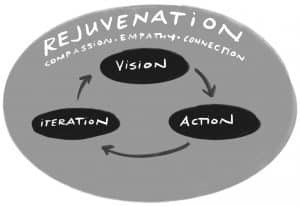
Our book details this process step by step, like looking under the hood to see what makes a Catalyst go. In our Catalyzing Organizational Change course, we take it a step further. Over six weeks, we walk through each component of the formula with small groups of Catalysts as they learn to apply those particular types of strengths in new ways, with stronger intention. Beyond simple analysis, we work alongside each other to develop the necessary catalyst muscles to more effectively create the change we need to see in the world.
The more familiar we become with the Catalyst Formula, the clearer we see it in motion every day of our lives, the better we can harness it. So let’s unpack a few key tools, one for each aspect of the Catalyst Formula, that can help you thrive as a Catalyst, no matter what kind of change you’re manifesting in the world.
Learn to Articulate the Vision
When we talk about Vision with Catalysts, it’s a little bit different than the way the general population thinks of it. This Catalyst superpower is not necessarily about a singular goal or ultimate finish line to drive toward. It’s an entire mode of thinking that we never shut down.
Our tentacles are always out there, feeling for what seems like limitless possibility. We’re gathering data not just in our literal research, but as we read a room, have conversations, learn more about our organizations, and become inspired by creative works.
We constantly pull this information in, from all sources, and that’s when the “magic” seems to happen. Our ability to connect the dots makes all of those disparate sources equally informative. The message in a science fiction novel connects to the concern a colleague had which connects to the stats a research team just compiled…and it all points to the solution to the gap in the organization that we’ve been trying to sort out.
But this happens so naturally and so clearly for us that we often just go after that solution, not realizing we’re the only ones who took that mental journey from point A to point Q all in an instant.
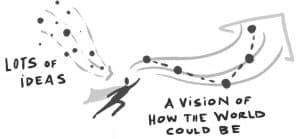
No matter how clear our visions for a better future are, most of us don’t know how to communicate that vision to anyone else.
In order to bring people along, we have to be able to show them where we’re going. And often, that must begin before the vision coalesces. In other words, sharing the vision begins with listening first.
The Listening Tour is a key Catalyst tool for shaping a clear vision that involves the people around you.
Take a period of time to simply listen and observe. Try to understand the context, challenges, needs, and success criteria of stakeholders across your organization. Be intentional in your conversations—about who those conversations are with and what opportunities or concerns you cover—to gather data to inform your vision. Ask them open ended questions and give them the time and space they need to share an in-depth view of their world. Focus on listening for deep understanding.
Not only is this a source of data for you as you’re connecting the dots toward that ultimate goal, but it helps the people around you appreciate at least a piece of the process as it unfolds. Taking the time to truly understand your stakeholders’ situation is a great way to start cultivating your vision in a way that invites cooperation. When they see their input in the vision you eventually share, it won’t seem quite so disruptive.
And, as simple as it sounds, remember to actually say your vision out loud once you come to clarity on it. Over and over and over again.
It’s common for Catalysts to move forward into action, after barely taking the time to fully form the vision in their minds—what it would look like once complete and who it would impact along the way—much less externalize it.
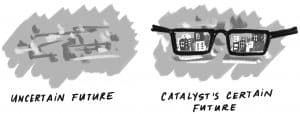
Take time early on to meet with someone “safe” (preferably someone who isn’t going to be impacted by the vision) and say it out loud to them. Get a feel for what that’s like. Make the case for it. Let them challenge you. Again, you’ll gain more data, and you’ll have a better idea of how to present it to stakeholders once it’s time.
Create and Use an Action Map
There is little on this earth more powerful than a Catalyst who can articulate and externalize their vision. Creating an Action Map is one of the best ways we ensure that vision has a chance to become reality.
This is one of the more concrete and helpful tools in the Catalyst’s arsenal, and one that we use every time we set out to create something new.
It’s exactly what it sounds like: a map of actions to be taken on the way to a vision. If you are here—what does your vision look like, when should it come to life, and what key stops are you going to have to make along the way?
The Action Map is helpful as a visioning tool, asking us to become more specific and clear about what it is we’re driving toward.
It’s a regrounding tool, asking us to stay focused as we move into action and begin to iterate on our planned steps.
And if we plot our own personal needs on it as well, it’s a rejuvenation tool, asking us to think of ourselves as whole people and not just vehicles for change.
The goal of an Action Map is to track your intended path so that the whirlwind of iteration doesn’t take you away from it.
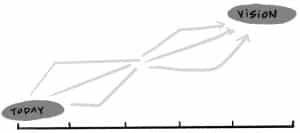
Once you’ve built an Action Map, keep it front and center. It should become a key tool that you use to prioritize your time and recap your accomplishments, even as you move forward in that non-linear way that most Catalysts are prone to. It can also become a reference point that helps other people know what you’re doing too.
You might create your Action Map on a spreadsheet, jot it down in a journal, or sketch it out with drawing tools. The actual format of the map isn’t important. What matters is whether you can use it to check in on your vision—updating it as needed, of course—and stay focused on the steps that will get you there. Keep your original Action Map and all subsequent versions to document the journey you’ve been on and the pivots that you’ve made based on input and data that you’ve gained along the way.
Count the Wins (and Losses)
In spite of the remarkable levels of change Catalysts are able to create, we don’t often feel successful. We move so quickly past our original (poorly articulated) goals that we forget how far we’ve come to get there.
That non-linear way of working tracks as constant effort without often registering as success. Yet when we look back on the previous year, we often find ourselves in a completely different place than where we started, with much progress being made, even if sometimes it was just helping the team come to clarity on “What next?”
This makes celebration another key tool for Catalysts to thrive—not just in the completion of a vision, but in the everyday small stuff.
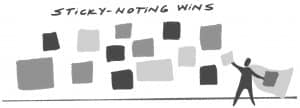
When you make an Action Map, you’re not just pointing the compass to the true north of a vision and setting out toward it. You’ve identified clear steps that will have to be taken along the way. Progress along that map is worth celebrating. Appreciate what you’ve accomplished, whether it’s landing that key meeting or clearing out those old files that held important information.
Similarly, you’re going to hit hard losses—maybe even on steps you were counting on being a win. Those are worth appreciating as well, because even failure is a form of information that can help you move forward. Reframing failure in this way is a key part of the successful Catalyst’s journey.
The losses can still hurt. You can still feel them and experience the consequences. But you don’t have to get stuck there.
Articulating the wins and losses, both as they happen and in retrospect, is important not just for you but also for your team or partners. We constantly find ourselves reminding each other to celebrate the small stuff and to look for the win that’s hidden in a loss. We try to toast the easy wins as much as the hard ones, because they’re only easy when they come on the heels of other wins we blew right past.
Learn to mark those moments that move you forward, even when they feel like a setback. Share the moment with people around you, so that they can learn to reframe failure and celebrate progress as well.
Over time, you’ll find that small but consistent moments of celebration or acknowledgment will keep others on the journey with you where they might otherwise feel left behind. And even if you’re all alone, they’ll help you create space to breathe for a moment and enjoy the work once more.
Track Your Energy
Embedded within each of the other key tools is this quiet reminder that you matter too.
A vision doesn’t come together as well if you aren’t present in each of your interactions with people and data and inspiration.
An Action Map isn’t as effective if the things you need as a person aren’t on at least a few stops as well.
Wins and losses are important for the team, but it’s just as much about your own satisfaction—reminders of how much joy this work actually gives you.
That’s where the final piece of the formula comes in, even though it’s more like a bubble encasing the whole Catalyst Formula within it. Rejuvenation is the slow burning fuel that makes the Catalyst keep running. Without it, we might burn hot, but we’re going to burn out fast.
We can become so externally focused on the change, that we forget to think about ourselves. That’s why so many of us hit exhaustion and burnout more deeply and with more frequency than non-Catalysts. The work that once gave us energy begins to take away from everything else that gives us energy, until all it does is take. Eventually, we have nothing left to give.
To start a practice of rejuvenation, start by simply tracking your energy.
What’s giving you energy and what’s taking it away?
Do you see a pattern of energy-draining or sustaining tasks? What about interactions? Is your role still one that brings you life and joy?

Because rejuvenation encompasses the whole Catalyst Formula, that awareness can affect each of the other tools, too. As you build your vision and map it out, consider what kind of energy you’ll have on the other side and what you’ll need to sustain it along the way. As you prioritize your day or week or month against the Action Map, think about what gives you energy and find a place for it on the map. When you hit a big win, use that energy as fuel to get you through a lower spot around the corner.
The Thriving Catalyst
No, these tools aren’t going to solve everything. You’re still going to move too fast, frustrate people and become frustrated, and lose more energy than you gain. You’re most likely going to burn out.
The difference comes with the level of intention that the tools create.
-
- The Listening Tour helps you shape a more well-rounded vision that others can see themselves in, and articulating that vision out loud helps you set off in a more specific and clear direction.
- The Action Map gives you a guiding star to prioritize by, to hold focus when iteration threatens to carry you away or when the midpoint starts to get tedious and boring.
- Celebration of wins big and small—and of what you learn from losses—brings energy and satisfaction back into the process of work itself.
- And when you track your energy, you’ll see even more of what feeds you as a Catalyst or seems to drag you down.
And that’s really the heart of it all: the tools you need the most are the ones that will help you thrive. You don’t have to fit anyone else’s expectations of what visioning looks like or what should or shouldn’t be energizing. You just need to live up to your own incredible potential, inside and out.
Because when you know that you’re a Catalyst—not a broken mess…
When you know you’re tracking toward a specific vision—not just making “magic”…
When you can see the map of actions that will get you there—holding yourself to your priorities instead of chasing every shiny new adventure…
When you can look back on your progress and celebrate clear wins and mark important losses—bringing your team along as pivots happen instead of jumping ahead alone…
When you can track your energy and truly value yourself as a key part of the changemaking process…
…That’s when you shift from surviving the world as a disruptor to changing it as a powerful, thriving Catalyst.
For more tools and exploration of how Catalysts work, get your copy of Move Fast. Break Shit. Burn Out. To build your Catalyst muscles with the community, our next Catalyzing Organizational Change course kicks off soon!

